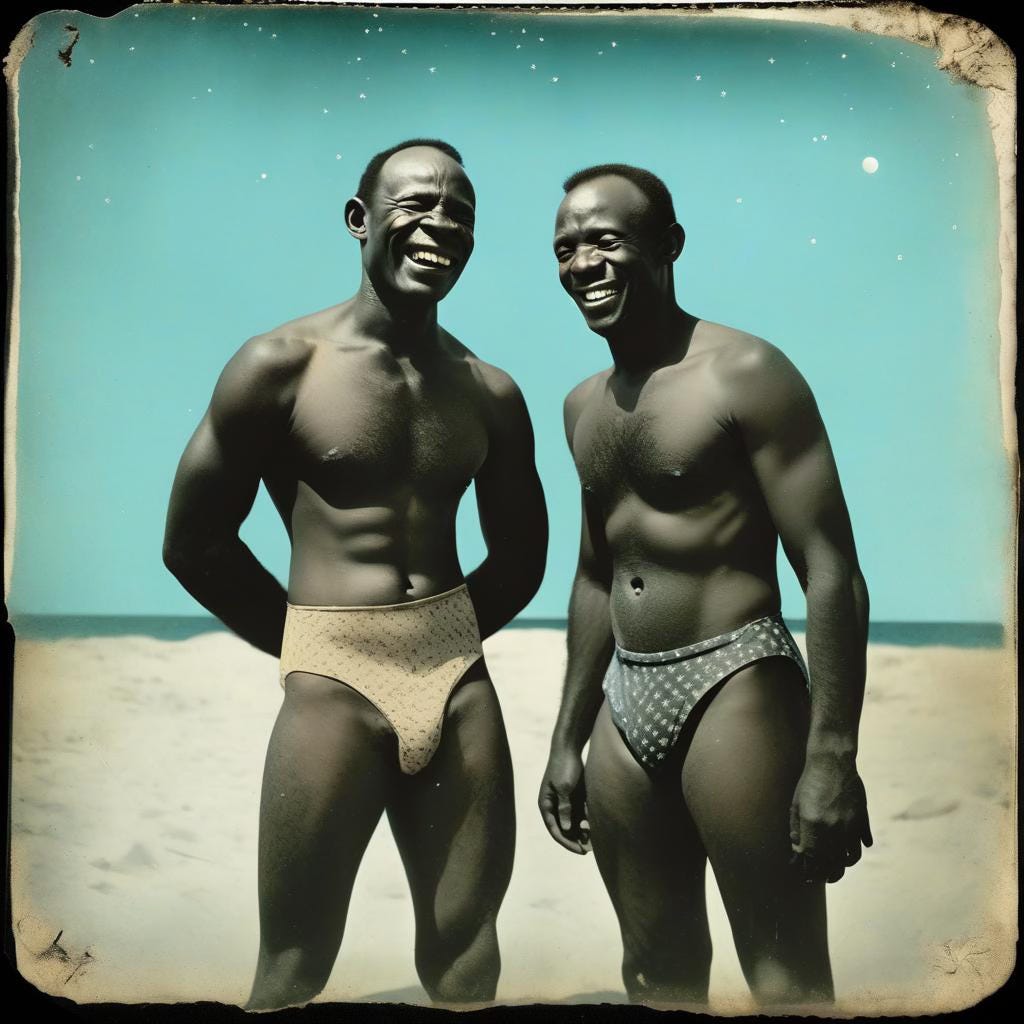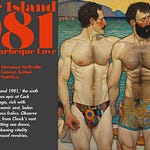This volume of the 50-part book series continues to follow our crew of 8 gay men vacationing on Fire Island, every year, for 50 years, tracing out the the last 5 decades of gay history. From a 350 page book styled after Virgina Woolf, and illustrated as though with photographs of 19th Century Tintypes, This is a video synopsis of the chapter, along with gay cultural milestones, and anecdotes of the year 1978. And, it is completely generated by AI, from the images, the 50-volume arc, the text, synopses, the anecdotes, even the programs which wrote it all. Only this posting, and the background music is Human-generated. It has lots of pretty images of half-naked men at the beach, which to me is exactly what gay men should be enjoying in the summer - get off the apps!
The AI book generator in its mysterious wisdom decided that, consistent with these types of vacation venues, there’s a Summer Theme (there’s always an event organized somehow by a chamber of commerce to lure tourists). This volume’s theme was historical gays on Fire Island, so consistent with that come Tintype Images.
One observation I’d like to share from this volume is that it felt very … natural. The problems in tintype photograph of the turn of the prior century are well-known - stilted posing (because of very long exposures required), low-resolution, usually quite shallow focus. Often images were accentuated with hand-painting, and hand-coloring, so they generally had more in common with perhaps Saturday Night Live title sequence images than what we’d consider high-quality digital photography today. Based on other photographic images generated, I think it wouldn’t be too far off to say that the state of the art for image synthesis feels like it’s around the tintype era.
Another example of Tintype photos I did was in a book - an AI Autobiography of Abraham Lincoln. Here’s the cover of the book. Any number of people would bet money the sad boy was absolutely Abraham Lincoln as a child. Unfortunately Abraham Lincoln was born in 1809, these images didn’t emerge until around 1850.
I love the nighttime images which were finally elicited in the process of generating the book images - delicately dark blue, with painted white pointed twinkling stars.
It makes me wonder quite a bit about tintypes in general. Men kissing, hugging, playing around were among the easiest to generate of all the style targets, which in my mind signifies that there were a log of examples from training sets. In my library I have a couple of volumes of books on images of men being romantic with each other stemming back to the origin of photographs, I feel it’s somehow quite probably that men were more affectionate before gay emerged in the early 20th century.
While Tom of Finland figures from Volume 1 were ‘hypermasculine’, the figures from Volume 2 paintings of Ford Madox Brown were more ordinary-sized and shaped, if not thick at times. This volume of male images could easily be yesterday at the beach in San Francisco, the beards, body hair, and muscularity. Gay friends I’ve show my experiments to tend to rate these pix higher on the ‘hotness’ scale at first glance. And some of the nicest are pure “Cheers”, if Cheers were a gay bar on Fire Island circa 1875.
I’ve read Virgina Woolf off and on through the years, and it came to me reading writing targeting her style that It’s the 21st century now. Her writing style sounds almost antique to me, and I didn’t expect that.
In the year 1978, the sunlit streets of San Francisco came alive with the vibrant hues and joyous clamor of the Castro Street Fair. This annual gathering, a jubilant celebration of gay culture, drew throngs of revelers. Here, beneath the ever-watchful gaze of the grand city, the essence of human spirit wove its tapestry, immersing all in a dance of color, laughter, and unity. Time seemed to pause, if only for a moment, enveloped in the warm embrace of acceptance and pride.
It’s completely consistent, but sounds so… Oscar Wilde.
In the year 1978, as the world turned upon its weary axis, the film 'La Cage aux Folles' burst forth as a brilliant comet in the night sky of cinema. It danced and dazzled, drawing the gaze of multitudes. This cinematic jewel unfurled the rich tapestry of gay culture, with a flourish both bold and tender, mirroring the sunlight upon the waves. It became, with fervor and acclaim, an international beacon, casting light upon the once shadowed realms, inviting one and all to partake in this newfound celebration.
I am trying to keep this all PG, but the hardcore descriptions of activities in the bushes by Virginia Woolf are quite peculiar. There’s something about men running around the beach sometimes naked, running off in the bushes, going to the disco dressed up in old crazy costumes, and mild intrigues a la “Tales of the City” which are just bit too saccharine but it is what it is.
Volume 2 “William Burroughs” styling can also be a bit dramatic.
Caught in the thick of it, the bar saturated with the haze of smoke, I observed Tyler and Hans. They were stationed like monuments of masculinity beside the sticky, spilled-fuel bar surface, a laugh burbling between them. The atmosphere crackled, pregnant with anticipation. As if frozen in a tableau, Hans’s hand, broad and articulate with veins like relief maps, stretched out lugging a glass, its contents swirling with promise.
Their laughter, deep-throated and rich, filled the bar, draping over the other chatter like a velvet throw. Such resonance! It was akin to the smooth, dark timbre of a well-oiled bass, rich with undertones of rough, unshaven nights and whispers of musk. The visual was just as potent: two towering figures, their broad shoulders haloed by the bar lights, casting shadows that mingled on the floor like dark, secret promises.
I certainly could smell the unshaven nights.
On to volume 4.
















Share this post